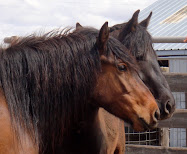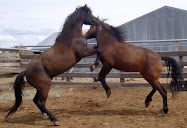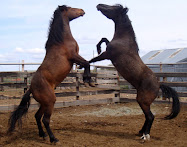I had almost forgotten all about writing about the ideas I had for managing mustangs until I came across a letter to the editor in the Sunday newspaper. It was written by Lorna Moffat and it did my heart good to read a letter from a fellow horse lover who truly cares about the welfare of America's wild horses.
Lorna wrote of the abusive horse round-ups carried out by the BLM and their contractors. Being limited to only 200 words she was only able to scratch the surface of the horrors of what our wild horses are put through.
I have read enough of the BLM's own documentation to be truly disturbed by these 'gathers' as they call them.
~~~~~~~~~~~~~~~~~~~~~~~~~~~~~~~~~~~~~~~~~~~~~~~~~~~~~~~
Here's a snippet about a gather;
CARSON CITY, Nev. -- The U.S. Bureau of Land Management suspended a wild horse roundup in northeast Nevada on Monday after seven animals died of dehydration and another was shot when it broke its leg in a holding pen.
Animal rights activists were outraged, saying the outcome was predicable given the sweltering temperatures and helicopters used to gather the animals.
The BLM said the animals appeared in otherwise good shape when two groups were herded by helicopter to holding pens in northern Elko County on Saturday. But the roundup was halted Sunday morning after four horses were found dead in the pens and others showed signs of colic and brain swelling.
Read more here;
~~~~~~~~~~~~~~~~~~~~~~~~~~~~~~~~~~~~~~~~~~~~~~~~~~~~~~~
Here's another snippet, this one from the Billings Gazette;
GREEN RIVER, Wyo. -- Federal cowboys completed one of the largest wild horse roundups in Wyoming history Saturday, gathering 2,269 horses during the month-long capture operation.
Bureau of Land Management wranglers returned 275 horses to the range.
Officials said nine horses died during roundup operations conducted in the huge Adobe Town and Salt Wells Creek herd management areas in Sweetwater and Carbon counties.
The Adobe Town and Salt Wells herds roam about 2.5 million acres of public, state and private lands. The BLM manages approximately 1.7 million acres within the two herd management units.
There will be approximately 860 wild horses remaining in the herd, BLM officials said Monday, which is the appropriate management level for the herd complex.
Six of the nine horses killed received injuries during roundup operations -- or had previous serious injuries or blindness — which led to the animals being destroyed by veterinarians.
They chased a blind horse for miles across rough terrain with a helicopter and when they had him trapped they killed him because he was blind.
THE BLIND HORSE HAD BEEN SURVIVING OUT IN THE WILD. THE BLM CHASED HIM WITH A HELICOPTER AND THEN THEY KILLED HIM. HE WASN'T LAME. HE RAN. HE RAN IN A PANIC CHASED BY A HELICOPTER. HE WAS A FIGHTER AND HE DESERVED TO LIVE BUT THE BLM CHASED HIM DOWN AND KILLED HIM BECAUSE HE WAS BLIND. WHY DIDN'T THEY LEAVE THIS HORSE BE?
Read more here;
~~~~~~~~~~~~~~~~~~~~~~~~~~~~~~~~~~~~~~~~~~~~~~~~~~~~~~~
These numbers are 2009 Bureau of Land Management numbers, as well as numbers obtained through independent investigation. Please understand that population levels in particular are fluid and subject to a significant degree of uncertainty (the same caveat applies to numbers provided by the BLM). - In the 19th century, more than 2 million wild horses roamed the West (source: J. Frank Dobie, “The Mustangs”, Southern Methodist University Press, Dallas, 1952).
- Today, less than 25,000 wild horses likely remain on public lands.
- Over 6 million head of private livestock enjoy subsidized grazing on public lands.
- More than 200,000 wild horses and burros have been removed from public lands since 1971. The BLM plans to remove another 6,000 for Fiscal Year 2009.
- The 1971 Wild Free-Roaming Horse and Burro Act mandates that wild horses and burros be managed on 47 million acres of public lands on 303 herd areas.
- Since 1971, wild horses have been zeroed out from 111 herd areas representing over 19 million acres.
- Wild burros numbered 14,000 at the time of the 1971 Act’s first census. Burros share their habitat with bighorn sheep, a highly-prized game species that now outnumbers them at least 16 to 1 on public lands. BLM’s target for nationwide burro population is less than 3,000.
- BLM relies on an annual population increase rate of about 20% to evaluate population levels and justify round-ups, while the National Academy of Sciences estimates that rate to be closer to 10%.
- Wild horses account for less than 0.5% of large grazing animals on public lands.
- 6 states have lost their entire wild horse and burro populations.
- In 70% of the remaining herd areas, BLM’s population targets are set at levels that will not ensure genetic viability.
- The current removal policy is costing over 39 million tax dollars a year.
- The removal and processing of a single horse through the adoption pipeline can cost as much as $3,000.
- Over 30,000 wild horses are currently held in government holding pens. Under the Burns Amendment, about 8,000 of them are threatened with slaughter.
- BLM’s private livestock grazing program encompasses 214 million acres of public lands, costs over $130 million to manage annually, yet only provides 3% of our national beef supply.
- The current fee to graze private cattle on public lands is $1.35 per animal unit month (AUM), the equivalent of $0.06 per acre per year, or about 1/10th of market rates to graze cattle on private lands.
- Private livestock outnumber wild horses and burros at least 200 to 1 on public lands. (note: some livestock may not be grazed year round)
- In 2008, less than 5% of BLM’s wild horse and burro program budget was allocated to herd management on the range, with the remaining 95% allocated to captures, holding and placement.
|
|
My idea is simple and would put a lot less stress on the horses. It was Echo who started me thinking about it. After Echo had been in Foxsun's old pasture for about two weeks I noticed he'd dug several large holes on the horse paths that run through the sagebrush. I guessed he was looking for salt or minerals because I'd forgotten to take his salt block to his new place.
It got me thinking about how they managed in the wild. He must have learned from the other mustangs or maybe his mother, how to dig for salt and I guess they would travel over great distances to their favorite minerals places. The same would be true for fresh water. Then the idea came to me that the BLM could keep lots of corrals in the horse management areas that contain fresh water and salt/mineral blocks.
When we need to get our cattle in, instead of driving them like we used to years ago on horse back, we have got them used to coming into the corrals for salt and mineral licks. Once all the cattle are in, you just close the gates. Corrals can be configured to work animals to where you want them by just moving them through various pens, closing more gates. There doesn't have to be any running for general mayhem and certainly no waving sticks with plastic bags tied to them. Our cattle have become very docile and friendly over the years. The calves learn from their mothers that they don't have to run from us.
The same would work for horses, they are after all domesticated animals but it takes patience and many years. The various corrals would be manned so the horse would get used to human activity and associate it with good things like water, salt and maybe hay..(?)... Wells could be dug for fresh water for them and even trees could be planted for shade and shelter from wind.
The practice of chasing the horses for miles with helicopters has to stop. I think this is a hold over from the days when the mustangs were unprotected and people used to fly over them to round them up. My plan takes more thinking and planing and I'm sure the BLM employees would far prefer to have the kind of control of the horses and all it could offer.
I believe the way to control population is with birth control for some while keeping others able to live a more natural wild way. Spaying mares would be cheaper than rounding them up and keeping them in long term holding for the rest of their lives.
Having the 'uncaptured' horses closer to the BLM employees would make it easier for the BLM to monitor their health and well being. Also it would let the BLM know what horses would be better suited for adoption based on their dispositions.
When you consider how many mustangs there are you will realise that finding adoptive homes for all of them is not at all realistic. Keeping them in BLM's concentration camps with no shade or shelter, is no way for a horse to live. On the range the horses, like cattle, can find shelter in the terrain of the land if nothing else.
Speaking of cattle; cattle are far more damaging to sagebrush country than horses. Our pastures are like the ones where the wild horses live in the west and so we see every day the difference between horse and cattle grazing. A horse can last a lot longer in a pasture than a cow. Cows are very hard on our land and it is the reason I haven't put Dandylyons in with Echo...she'd eat him out of house and home in no time, yet two horses could almost graze year round. Echo is eating only half his hay because he is eating the native grass which is still growing enough to fill him if he was out there all day.
Brad's family have had cattle on this place since the late 1880's and Brad has got a degree from WSU in Animal Science, so we know a bit of what we're talking about. The reason why the cattle are not on the ranges year round like the horses is because they would run out of enough feed to keep them plump and have to be brought in to be fed..while a horse can maintain his weight better on less.






2 comments:
I've been blogging on this for the last couple of weeks--it's called "baiting" and they already do it in some roundups--and yes, it is much more humane. However, the problem is they have to limit the breeding--and that's why we're discussing PZP--the wildlife contraceptive. What I'd like to see--and TJ from Spring Creek Basin--is humane baiting with mineral blocks--conducted by volunteers (friends of Mustangs in coalition with BLM) and administering PZP by dart--like they do on Asseteague, and then a quick release.
Thanks so much for posting about TJ. I have caught up on my reading.
I think it's quiet good that the salt/mineral idea is already being done. Clever Echo to show me. :)
It's funny because when I put down a little trail of hay to get the cows to go in certain pens, I call it 'cow bait'. lol.
Post a Comment